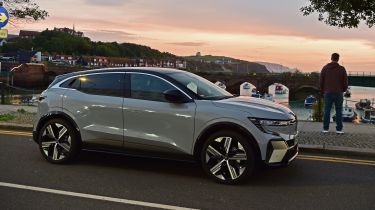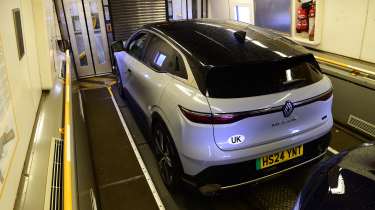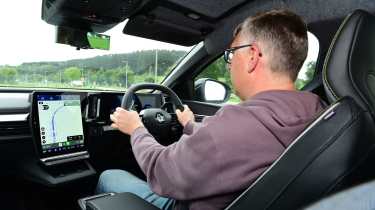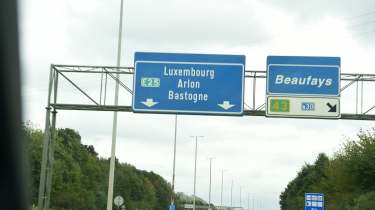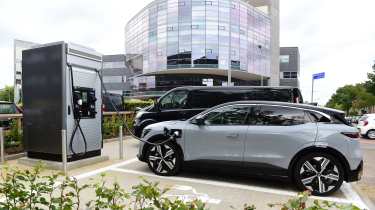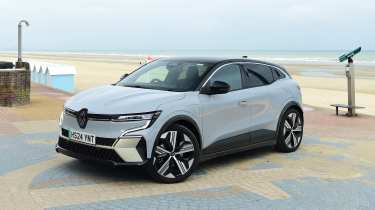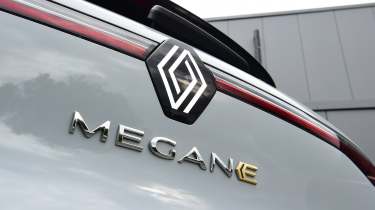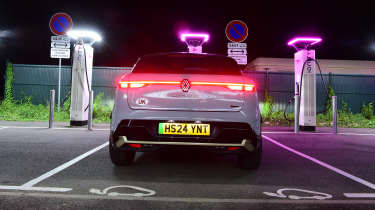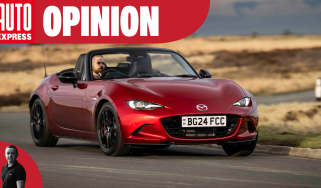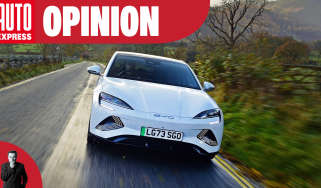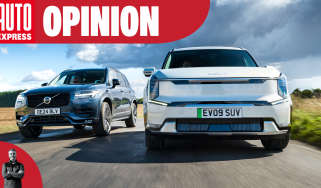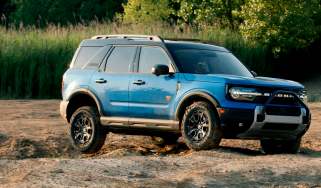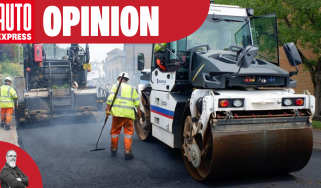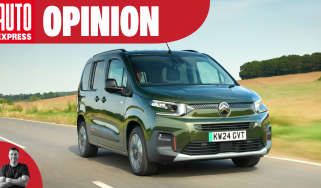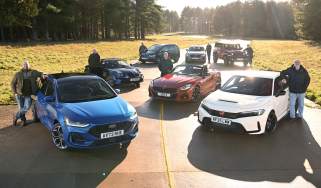Renault Megane EV charging across Europe: 7 countries, 24-hours, no plan
Can you drive an electric car across Europe with no planning? We take a road trip to find out...
“We've got this clever new app that means you can access EV chargers anywhere in Europe and pay for it all in one place. Fancy putting it to the test?”
A simple question, and one that spiralled into conversations about how many different countries we could charge an EV in across one day. Without any planning.
Renault’s Mobilize Power Solutions app has 700,000 charging points searchable by type of plug, charger power and number of connectors, as well as by availability – all of which can be activated using the app, or the RFID card that comes with an account. It’s aimed at Renault’s business customers, so that companies can have all their charging on one bill across multiple users.
But we’re gatecrashing it for the day, rather than using the My Renault and Mobilize Charge Pass apps for private buyers. It’s simple – use each stop to plot the next leg using the app, and see how many countries we can then plug into in 24 hours.
Which explains why we meet our photographer Pete at Folkestone harbour a bit before daybreak on a Tuesday in early September, for a drive that would later turn out to include nine border crossings, hundreds of miles and, according to Pete, nowhere near enough coffee.
The vehicle of choice is the updated Renault Megane, and the trip is a good chance to spend some time with this new 2024 model. The upgrades to a car that only launched two years ago aren’t massive, but make a big difference to the interior thanks to the larger 12-inch screen now fitted to mid-range Techno and top-spec Iconic trim levels.
Other changes include a heat pump as standard – very useful for protecting the range of an EV and something not fitted as standard to every electric car – and what Renault calls its contextual adaptive cruise control.
An official range of 281 miles gives us plenty of flexibility, and the 217bhp powertrain offers a good balance for a task that’s as much about efficiency, as well as how quickly you can get to where you need to go.
Leg one: Folkestone to Ghent (Belgium) 108 miles - Arrival time: 11.09
It would be wasteful not to charge in the country we’re in, so the UK is ticked off with a quick pre-dawn top-up at the Ionity chargepoint in Folkestone’s Stop 24 service station. It’s a glamorous start at least, before heading for the Eurotunnel to plot how to approach the task in hand, while waiting to board the train for a rapid hop under the Channel.
The trouble with popping out in Calais is that if you head east, France is a bit short for a car that was fully charged just the other side of the water, so we take the decision to come back to a French charger later. It’s a big country after all, so we’ll find our way back. Instead, we aim for Belgium. Ghent seems like a good spot.
Rather than diving into motorway service stations, it seems rude not to at least take in some of the local sights, which includes a quick trip to the beach at Dunkirk for some bracing sea air and a glance back across the Channel towards the UK (as well as some nice scenery to keep Pete happy) before pressing on to a city famous for its medieval architecture, which we have more chance of taking in than we do Belgium’s famous beer or chocolate. Unfortunately.
It’s obvious we’re not in Folkestone anymore. It takes a mental adjustment to come off a 90km/h (56mph) road and be checking for the cyclists that have right of way as we swing onto the slip road. Then there’s sharing the road space with trams, but against a background of more elegant and heritage-filled architecture than the likes of Croydon can only dream of. The Megane’s good forward visibility, including handily small A-pillars, at least makes it easy enough to spot cyclists emerging from the many local paths.
When we get to the sports centre that houses the big bank of chargers we’ve picked out on the Mobilize app, the bad news is that a Ford Mustang Mach-E has beaten us to the only fast- charging 120kW unit. All is not lost, however, thanks to a row of 50kW chargers – meaning it takes an extra few minutes to top up to 80 per cent, which ensures a bit more time than we really need to plot the next target.
Leg two: Ghent to Maastricht (Netherlands) 102 miles - Arrival time: 14.37
Maastricht almost feels like a cheat being so close to the border, but it’s in the Netherlands, so it counts. There are also trams, lots more trams, and they mix with traffic in a way seemingly designed to build fear in the uninitiated.
But the fast-charging point in the city is easy enough to find, (we won’t talk about the slight miscalculation with plan A, where it wasn’t quite the right side of the Belgian/Dutch border, but at least it shows we’re taking it seriously...) and we’re fortunate that it’s a vacant 300kW charger, mere metres inside the country.
After a little deviation leaving Ghent to find a nice photo location, and slow roads that follow, we’re already nervously eyeing the clock if we’re going to tick off all the countries we’re aiming for. So even though the car won’t charge at the full 300kW (very few do yet, but at least the chargers exist), it’s handy to find a super-fast charger that limits the time at a standstill, and a quick check on the app to find our next stop comes with the first bit of route debate. From the Netherlands, back into Belgium and down to tick off Luxembourg seems like the best plan, but we choose to be ambitious and aim south, assuming Belgian motorways will be quicker than traversing the length of the small, landlocked country.
Leg three: Maastricht to Dudelingen (Luxembourg) 136 miles - Arrival time: 18.47
SOME rush-hour traffic, especially the agonising final five kilometres (3.1 miles) to the charging point in Luxembourg, isn’t helping us. This is the longest leg so far, mostly on Belgian motorways that are dominated by the view of two trucks side-by-side on the dual-carriageway sections. They highlight how effective adaptive cruise control is at slowing and then rapidly picking back up speed once the obstruction has returned to the inside lane. At least it saves us some range by holding us shy of the 120km/h (74mph) speed limit.
It’s the eternal electric-car dilemma on longer trips: increased speed, especially above 60mph, can really take its toll on the battery. So do you ease back, enjoy the drive and conserve battery, or take the hit on range and get there quicker?
We favour the latter, but it does mean the battery is more depleted than might have been the case when we make it to the Esso garage at Dudelingen. The location seems to double-up as a booze wholesaler, so presumably the French
nip over the border moonshine-style to take advantage of Luxembourg’s low alcohol duty rates. There's none of that for us today, though, as appealing as it looks after 12 hours on the road, but at least the stop gives us a chance to rest, eat, and plan, while another 300kW charger does its thing topping up the electricity we’d blasted away on the Belgian motorway network.
Leg four: Dudelingen to Bernolsheim (France) 121 miles - Arrival time: 21.21
From Luxembourg, the borders get closer together, so the speed versus efficiency dilemma becomes less of a consideration – we just take the hit to get between stops faster. It’s also time to fulfil our promise to return to France.
Relentless positivity means we’re hoping to still hit seven countries in one day, despite time ebbing away, which makes it doubly frustrating to encounter our first non-seamless charging experience. So far it’s been a case of finding a charging point on the Mobilize app, sending the route to Google Maps, Apple Maps or Waze, and then letting the Megane point us there. Once we’re at the chargepoint, we can start charging with the app, but this Ionity point has decided not to play ball. After a bit of faffing, we get the charge; I’m blaming Ionity rather than Mobilize –Renault’s app and contactless cards brought no oy, but going through Ionity’s own online process did the job.
That’s happened before – wider-use apps working perfectly well before and after an attempt at Ionity, but the chargers only spring into action when you go through its own. As an aside, exactly the same thing happens the following day on the run back to the UK, which makes me doubly convinced it’s an Ionity glitch.
This charging stop also offers Pete a new challenge, to make our grey car look pretty in the dark and deserted Super U car park on the outskirts of Bernolsheim. Pete running round trying to light the Megane in a dingy car park causes some confusion for the occupants of the BMW i4 and Polestar 2 parked either side of us, which serves as suitable entertainment as we eye the map to work out what we can achieve with less than three hours of the day remaining.
Leg five: Strasbourg to Frieberg im Breisgu (Germany) 70 miles - Arrival time: 22.53
That thing we mentioned earlier about balancing time and efficiency kind of goes out of the window when faced with a clock ticking rapidly towards midnight and a derestricted piece of German autobahn ahead of you.
After negotiating Strasbourg, which is easy due to the fact that most sensible people are at home, the German border rapidly approaches, and some diligent research confirms that Renault’s official 99mph top speed converts to an indicated 103mph, or 165km/h, on an almost deserted piece of derestricted motorway.
It also shows that driving flat-out is a great way to run the battery down very quickly. But at this point we’re invested in the theory that faster speed and a bit more charging time is probably better than a nice sedate cruise. As well as being more fun.
EVs aren’t at their most efficient at higher speeds, so every longer trip is a balancing act depending on where you’re going to charge and how close to empty you’re willing to get. With the Megane, the car starts getting nervous enough to warn us at 15 per cent remaining, which is easy for making our charging plan, given how many public chargepoints there are.
Plus it’s a short leg to our German stop, so there’s no worry about running short on energy. Pete and I aren’t exactly daisy-fresh by now, but sweets and coffee help.
No time for the niceties of lovely city-centre photo locations now, so it’s a dive into a motorway service station to get enough charge to try and tick off one more country before the clock chimes midnight, the car turns into a pumpkin and Pete’s glass slipper is left by the roadside.
Leg six: Frieberg im Breisgu to Basel (Switzerland) 44 miles - Arrival time: 00.03
We didn’t make a seventh country in one day. But three minutes was close. Travelling at this time of night throws in another element when picking a chargepoint – will it be accessible, and safe? Luckily Mobiize’s app lets you view Google Street View images to see locations, to at least get an idea of how much you fancy hanging around in the middle of the night.
In this case, we are focused purely on the first charging point across the border into Switzerland, in an (ultimately unsuccessful) attempt to have the car charging on Swiss soil before midnight.
The chargepoint is in a small car park under a six-lane flyover, with the street lamps providing an eerie orange glow. But there’s a final spanner in the works, because that flyover seems to block any phone signal and we can’t get the charger working via the app. That’s where the back-up RFID card is handy, saving the day on the handful of units that still don’t accept contactless payment. At this point it’s purely about getting enough charge to hop 20 minutes up the road back into France for a ninth border crossing in well under 24 hours.
Charging the Megane for the return trip north back to the UK feels very much like it's a post-sleep, post-croissant, post-coffee (tomorrow) kind of problem.
Done and dusted
So, what did we learn? We’d travelled across France in an EV once before on holiday, and for that trip spent an entire Sunday afternoon setting out Plan A, B and C in case chargers weren’t working, wouldn’t connect, or were too far apart. So we had a little experience – in France at least. But this trip involved minimal planning – we’d looked at a map of Europe to work out a rough route, but hadn’t pinpointed a single chargepoint beyond Folkestone until we were waiting for Le Shuttle. With a couple of very minor hiccups, our first choice charger gave us what we needed across seven different countries in the same day. Give or take three minutes.
There is understandably more trepidation around taking the plunge to go long distances in an EV than a petrol car, and it’s a different experience having to consider slowing down to increase efficiency. The same applies in a petrol car, but there’s something about the battery percentage dropping that has an immediate impact on when and where you next feel the need to stop than finding a petrol station. That’s before you consider how much longer it’ll take you to refill, or how far you’ll get on a charge.
Apart from the time we had to slum it on a 50kW charger rather than the 120kW unit that was occupied, there were always plenty of high- powered points available, no matter which country. Knowing you’re going to be stopping for maybe half an hour every couple of hours leads to a different mentality, because you end up embracing more relaxed progress. Yes a petrol car would have picked off the 600+ miles faster, but if this sort of journey is the exception rather than the rule, and EVs otherwise fit into your life and routine, then there’s no reason to fear a cross-border road trip powered by electricity.
Fancy taking a fully-electric road trip? These are the longest range electric cars on sale...
Find a car with the experts

